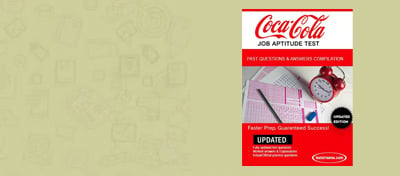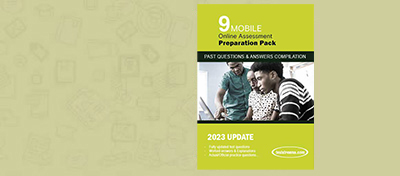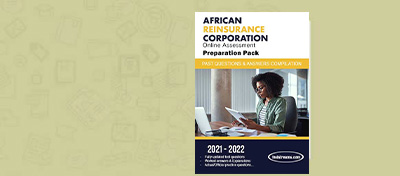Free-Cocacola Aptitude Test past questions and answers- PDF Download
If you’re gearing up for a career with one of the world’s most iconic and renowned companies, Coca-Cola, then mastering the aptitude test is a crucial step toward achieving your goal. As you prepare for this exciting opportunity, we’ve compiled a comprehensive guide that includes past questions and answers to help you confidently navigate the Coca-Cola Aptitude Test.
About Cocacola
1917
The Coca‑Cola Company began its partnership with The Red Cross. During World War I, the Coca‑Cola system ran annual Red Cross drive campaigns which continued for over a decade. This partnership remains strong today and has been essential to the company’s involvement in disaster relief throughout the years.
1935
Lettie Pate Evans joined the Board of Directors as the 1st woman to serve on the board of a major company.
1963
The Coca‑Cola Company produced its first diet drink, Tab. Tab was introduced before the early growth of the low-calorie soft drink segment, and the beverage was developed for consumers who wished “to keep tab on their calories.” Several women chemists played a critical role in the development of Tab.
1966
The Coca‑Cola Company launched “The Nutrition Project”, assigning an international team of scientists and food technologists the task of finding a solution to the “protein gap” facing the impoverished nations of the world and provide more light, protein-rich beverages to consumers. This project led to the introduction of the brands Saci, Sanson and Taí, three protein-rich energy beverages developed in Latin America, utilizing the local ingredients such as soybeans and whey as protein source ingredients for the beverages.
1984
The Coca‑Cola Foundation was founded. The Coca‑Cola Company is committed to giving back 1 percent of its prior year’s operating income annually through the foundation. The foundation serves three priority areas: women, water and well-being.
2001
The Coca‑Cola Company established the Coca‑Cola Africa Foundation, which has worked to prevent and treat HIV/AIDS in Africa. Since it was established, the Coca‑Cola Africa Foundation has launched numerous projects and initiatives throughout Africa.
2007
The Coca‑Cola Company announced a transformational partnership with the World Wide Fund for Nature (WWF) to address challenges related to freshwater conservation. This partnership focused on five core areas including the following: conserve seven of the world’s most important freshwater basins, improve water efficiency within the company’s operations, reduce the company’s carbon emissions, promote sustainable agriculture and inspire a global movement to conserve water.
Understanding the Coca-Cola Aptitude Test
The Coca-Cola Aptitude Test is a rigorous assessment designed to evaluate a candidate’s logical reasoning, critical thinking, and problem-solving abilities. It consists of multiple-choice questions that cover a wide range of topics, including mathematics, verbal reasoning, and analytical skills. By familiarizing yourself with past questions and answers, you’ll gain a competitive edge and increase your chances of success.
Why Practicing Past Questions
Insight into Question Patterns: By reviewing past questions, you’ll identify recurring patterns and themes that the test tends to focus on. This insight enables you to tailor your preparation and allocate more time to areas where you may need additional practice.
Time Management: Time is of the essence during the aptitude test. Practicing past questions allows you to develop effective time management strategies, ensuring that you can confidently complete the test within the allocated timeframe.
Enhanced Confidence: Familiarity breeds confidence. As you tackle past questions and see your progress, you’ll naturally build confidence in your abilities, reducing test anxiety and enhancing your performance.
Refined Problem-Solving Skills: The Coca-Cola Aptitude Test assesses your ability to think critically and solve complex problems. Regular practice with past questions sharpens these skills, making you better equipped to tackle new challenges.
Free-Cocacola Sample Past Questions and Answers
VERBAL REASONING
Question 1:
Choose the word that is opposite in meaning to “expensive.”
A) Inexpensive
B) Valuable
C) Extravagant
D) Luxurious
Answer 1:
A) Inexpensive
Question 2:
Which word is a synonym for “elated”?
A) Sad
B) Angry
C) Excited
D) Bored
Answer 2:
C) Excited
Question 3:
Identify the correct sentence:
A) The team is playing their best.
B) The team are playing their best.
C) The team is playing it’s best.
D) The team am playing their best.
Answer 3:
A) The team is playing their best.
Question 4:
Choose the option that correctly completes the analogy:
Music : Note :: Literature : ______
A) Story
B) Chapter
C) Paragraph
D) Sentence
Answer 4:
D) Sentence
Question 5:
Select the word that best fits in the blank:
She has a _______ for playing the piano.
A) Knack
B) Repulsion
C) Detachment
D) Aversion
Answer 5:
A) Knack
Question 6:
Identify the correctly spelled word:
A) Accomodate
B) Accommodate
C) Acommodate
D) Accommodatee
Answer 6:
B) Accommodate
Question 7:
Choose the option that forms a logical pair similar to “doctor : stethoscope.”
A) Teacher : Chalk
B) Artist : Paintbrush
C) Pilot : Compass
D) Chef : Oven
Answer 7:
B) Artist : Paintbrush
Question 8:
Select the word that best describes the situation: “Unsure about the outcome.”
A) Confident
B) Certain
C) Doubtful
D) Optimistic
Answer 8:
C) Doubtful
Question 9:
Which phrase is a metaphor?
A) She is as fast as a cheetah.
B) She runs very quickly.
C) She is a fast runner.
D) She can outrun anyone.
Answer 9:
A) She is as fast as a cheetah.
Question 10:
Identify the correct sentence:
A) The cat laid on the mat.
B) The cat lain on the mat.
C) The cat has lay on the mat.
D) The cat lay on the mat.
Answer 10:
D) The cat lay on the mat.
LOGICAL REASONING
Question 1:
If all trucks are vehicles, and some vehicles are red, which statement must be true?
A) Some trucks are red.
B) All vehicles are red.
C) All trucks are red.
D) No trucks are red.
Answer 1
A) Some trucks are red.
Question 2:
If A is taller than B, and B is taller than C, which of the following is correct?
A) A is the tallest.
B) B is the tallest.
C) C is the tallest.
D) The order cannot be determined.
Answer 2:
D) The order cannot be determined.
Question 3:
If all cats have tails, and Fluffy is a cat, what can you conclude?
A) Fluffy has a tail.
B) Fluffy is tailless.
C) Fluffy is a dog.
D) Cats don’t have tails.
Answer 3:
A) Fluffy has a tail.
Question 4:
All fruits are healthy. Apples are fruits. What can we say about apples?
A) Apples are unhealthy.
B) Apples are not fruits.
C) Apples are healthy.
D) Apples are vegetables.
Answer 4:
C) Apples are healthy.
Question 5:
If all roses are flowers, and some flowers are red, what can we infer about roses?
A) All roses are red.
B) Some roses are red.
C) No roses are red.
D) Roses are not flowers.
Answer 5:
B) Some roses are red.
Question 6:
If only athletes are strong, and John is strong, is John an athlete?
A) Yes, he must be an athlete.
B) No, he can’t be an athlete.
C) Maybe, he could be an athlete.
D) Not enough information to determine.
Answer 6:
D) Not enough information to determine.
Question 7:
If pencils are stationery items and some stationery items are on sale, are pencils on sale?
A) Yes, pencils are on sale.
B) No, pencils are not on sale.
C) Maybe, pencils could be on sale.
D) Pencils are never on sale.
Answer 7:
C) Maybe, pencils could be on sale.
Question 8:
If no birds can swim and some penguins are birds, can any penguins swim?
A) Yes, all penguins can swim.
B) No, no penguins can swim.
C) Maybe, some penguins can swim.
D) Penguins can only fly.
Answer 8:
B) No, no penguins can swim.
Question 9:
If buses run on gas and the blue bus is a bus, what can we say about the blue bus?
A) The blue bus runs on gas.
B) The blue bus doesn’t run on gas.
C) The blue bus is a car.
D) The blue bus is not a vehicle.
Answer 9:
A) The blue bus runs on gas.
Question 10:
If all cakes are sweet and this dessert is sweet, what can we conclude about the dessert?
A) The dessert is a cake.
B) The dessert is not sweet.
C) The dessert is not a cake.
D) The dessert is a vegetable.
Answer 10:
C) The dessert is not a cake.



![GTI Microfinance Bank Aptitude Test Past Questions and Answers [Free – PDF Download] GTI Microfinance Bank Aptitude Test Past Questions and Answers [Free – PDF Download]](https://teststreams.com/blog/wp-content/uploads/2023/08/GTI.jpg)

